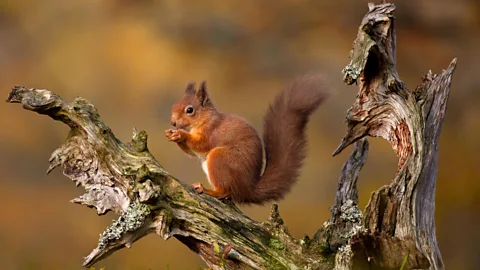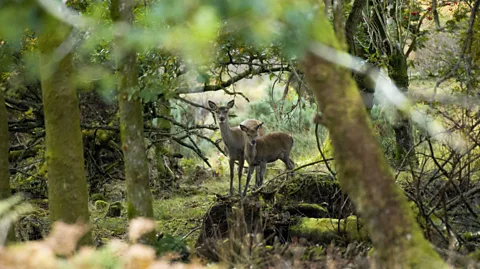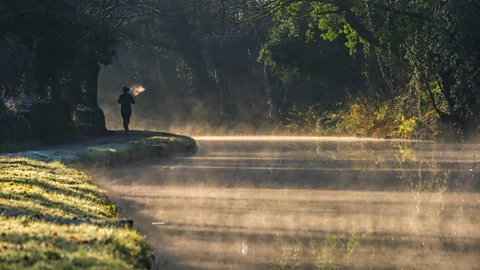The great experiment to put a price on nature
 Getty Images
Getty ImagesFresh water, clean air, peace of mind – natural landscapes make life better for humans in myriad ways. Now scientists are trying to put a dollar figure on exactly how much nature is worth.
Tucked away in the Scottish Highlands, in an old commercial forest known as Birchfield near Loch Ness, is a rewilding project with a difference.
The 100-acre (40-hectare) site is a hive of technological activity. Drones fly overhead to track the extent and condition of the various habitats below, from recently felled woodland to a newly discovered peat bog. Meanwhile, camera traps and audio recording equipment capture evidence of the huge variety of species that live on the land.
However, as well as tracking the physical changes taking place as the land is restored, researchers are busy calculating exactly how much we benefit from that restoration, in the cold hard currency of money and economic worth. This is the Natural Capital Laboratory.
The idea of putting a price on carbon is familiar by now – buy a plane ticket and you might have the option to pay extra to offset your emissions – but nature does a lot more than absorb carbon. Around the world forests provide homes, food and resources for humans and animals alike. Trees also cut air pollution, reduce the risk of flooding and help maintain soil quality. Landscapes like grasslands and coastal wetlands provide for humans, and countless other species, in many ways. Animals within these ecosystems also provide services, such as insect pollination or the carbon storage of elephants or whales. What happens when we try to put a price on those things too?
 Getty Images
Getty ImagesTalks at the United Nations' 26th Climate Change Conference of the Parties in Glasgow this November, known as COP26, will address how to implement a global carbon market, enabling countries to trade carbon credits in order to meet their emissions targets. At the same time, private sector investors and companies are looking to carbon markets as a solution to regulatory measures that will enforce decarbonisation. "There's a tremendous political push for this," says Alain Frechette, director of strategic analysis and global engagement at Rights and Resources Initiative (RRI), a community land rights coalition.
In theory, a global carbon market should mean we reduce emissions across the whole planet. Rich countries could meet targets while continuing to emit by paying for reductions elsewhere – and lower income countries could benefit financially from restoring their climate-friendly landscapes. But the devil will be in the details. If we don't get it right, a global carbon market could lead to a land grab that devastates communities living in the world's richest landscapes, and wreaks havoc on wildlife, too. (Read more on how a global carbon market could affect the climate.)
Whatever happens at COP26, action on climate change is already affecting the way we value land and ecosystems. Gabon is a net sequester of carbon thanks to the rainforest that covers most of the country. This year the UN-backed Central African Forest Initiative paid the country $17m (£12m) for reducing emissions from deforestation in recent years.
Similarly, the Seychelles had almost $22m (£16.8m) of national debt paid off by US conservation group The Nature Conservancy in return for protecting its coastal wetlands, another habitat that is a significant carbon sink and home to endangered species, including the hawksbill sea turtle and scalloped hammerhead shark.
But the myriad ways that land provides for humans by supplying clean air and water, mitigating flood risk, and more – known as "ecosystem services" – have not always been afforded a monetary value. Felling a woodland for timber has a market value, but protecting it to reduce the risk of devastating floods in a local town, for example, usually does not.
The concept of ecosystem services was developed in the 1970s. It was originally intended to highlight our dependence on nature and get people interested in conservation, but later evolved into a way of putting a price tag on those benefits.
Now there is a growing movement towards paying to protect these services. It's not a wholly new idea: in 1989 bottled water brand Vittel, now owned by Nestle, began a consultation that resulted in a financial agreement with farmers upstream of the company's water source, essentially paying them to ensure an aquifer provided clean water.
For some, putting a price on ecosystem services is how we can make sure nature – or rather, natural capital – is given due weight at the decision-making table.
 Getty Images
Getty Images"It's about 'what is the value that we've not been recognising in the past">window._taboola = window._taboola || []; _taboola.push({ mode: 'alternating-thumbnails-a', container: 'taboola-below-article', placement: 'Below Article', target_type: 'mix' });
